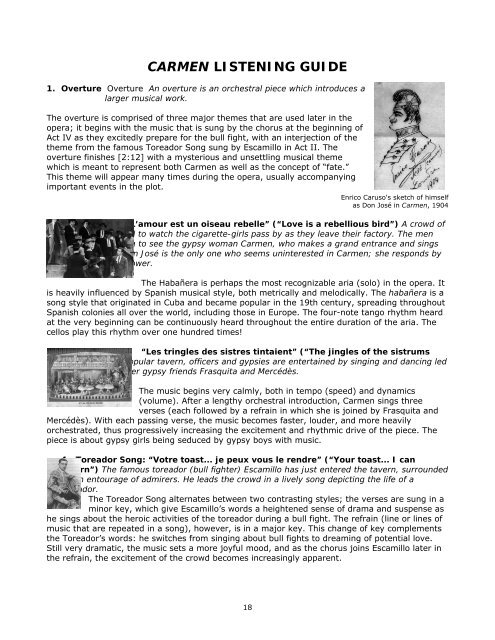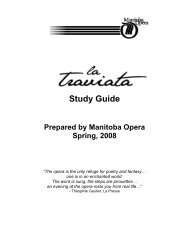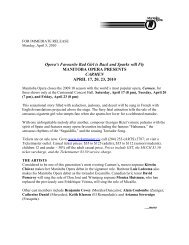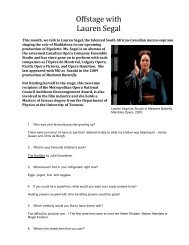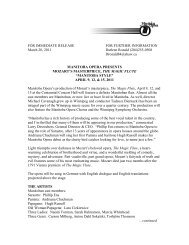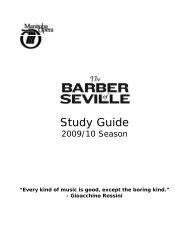Create successful ePaper yourself
Turn your PDF publications into a flip-book with our unique Google optimized e-Paper software.
CARMEN LISTENING GUIDE<br />
1. Overture Overture An overture is an orchestral piece which introduces a<br />
larger musical work.<br />
The overture is comprised of three major themes that are used later in the<br />
opera; it begins with the music that is sung by the chorus at the beginning of<br />
Act IV as they excitedly prepare for the bull fight, with an interjection of the<br />
theme from the famous Toreador Song sung by Escamillo in Act II. The<br />
overture finishes [2:12] with a mysterious and unsettling musical theme<br />
which is meant to represent both <strong>Carmen</strong> as well as the concept of “fate.”<br />
This theme will appear many times during the opera, usually accompanying<br />
important events in the plot.<br />
Enrico Caruso's sketch of himself<br />
as Don José in <strong>Carmen</strong>, 1904<br />
2. Habañera: “L’amour est un oiseau rebelle” (“Love is a rebellious bird”) A crowd of<br />
men has gathered to watch the cigarette-girls pass by as they leave their factory. The men<br />
have been waiting to see the gypsy woman <strong>Carmen</strong>, who makes a grand entrance and sings<br />
the Habañera. Don José is the only one who seems uninterested in <strong>Carmen</strong>; she responds by<br />
throwing him a flower.<br />
The Habañera is perhaps the most recognizable aria (solo) in the opera. It<br />
is heavily influenced by Spanish musical style, both metrically and melodically. The habañera<br />
is a<br />
song style that originated in Cuba and became popular in the 19th century, spreading throughout<br />
Spanish colonies all over the world, including those in Europe. The four-note tango rhythm heard<br />
at the very beginning can be continuously heard throughout the entire duration of the aria. The<br />
cellos play this rhythm over one hundred times!<br />
3. “Les tringles des sistres tintaient” (“The jingles of the sistrums<br />
tinkled”) In a popular tavern, officers and gypsies are entertained by singing and dancing led<br />
by <strong>Carmen</strong> and her gypsy friends Frasquita and Mercédès.<br />
The music begins very calmly, both in tempo (speed) and dynamics<br />
(volume). After a lengthy orchestral introduction, <strong>Carmen</strong> sings three<br />
verses (each followed by a refrain in which she is joined by Frasquita and<br />
Mercédès). With each passing verse, the music becomes faster, louder, and more heavily<br />
orchestrated, thus progressively increasing the excitement and rhythmic drive of the piece. The<br />
piece is about gypsy girls being seduced by gypsy boys with music.<br />
4. Toreador Song: “Votre toast... je peux vous le rendre” (“Your toast... I can<br />
return”) The famous toreador (bull fighter) Escamillo has just entered the tavern, surrounded<br />
by an entourage of admirers. He leads the crowd in a lively song depicting the life of a<br />
toreador.<br />
The Toreador Song alternates between two contrasting styles; the verses are sung in a<br />
minor key, which give Escamillo’s words a heightened sense of drama and suspense as<br />
he sings about the heroic activities of the toreador during a bull fight. The refrain (line or lines of<br />
music that are repeated in a song), however, is in a major key. This change of key complements<br />
the Toreador’s words: he switches from singing about bull fights to dreaming of potential love.<br />
Still very dramatic, the music sets a more joyful mood, and as the chorus joins Escamillo later in<br />
the refrain, the excitement of the crowd becomes increasingly apparent.<br />
18


